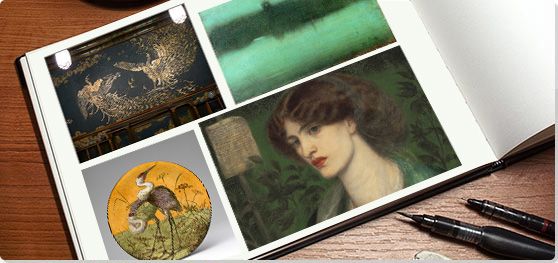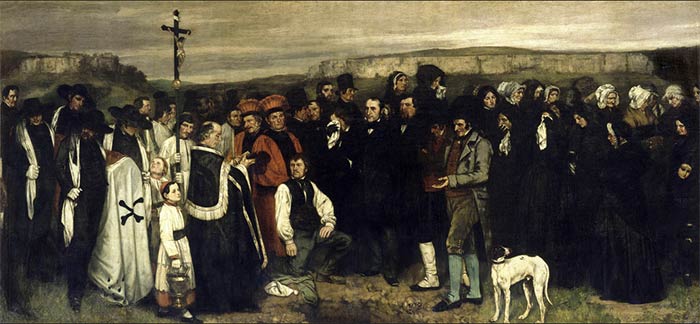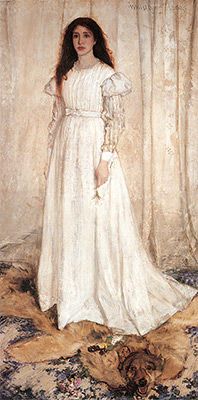Summary of The Aesthetic Movement
During the mid-19th century, the provocative and sensuous Aesthetic movement threatened to dismantle Britain's fussy, overbearing, and conservative Victorian traditions. More than a fine art movement, Aestheticism penetrated all areas of life - from music and literature to interior design and fashion. At its heart was the desire to create "art for art's sake" and to exalt taste, the pursuit of beauty, and self-expression over moral expectations and restrictive conformity. The freedom of creative expression and sensuality that Aestheticism promoted exhilarated its adherents, but it also made them the object of ridicule among conservative Victorians. Nonetheless, by rejecting art's traditionally didactic obligations and focusing on self-expression, the Aesthetic movement helped set the stage for global, 20th-century modern art.
Key Ideas & Accomplishments
- Rebelling against Victorian materiality and modern industrialism (particularly what they criticized as the impoverished and repetitive designs of consumer products created cheaply by "soulless" machines), Aesthetic artists placed a premium on quality craftsmanship in the creation of all art. Some even revived pre-industrial techniques in the process.
- Aesthetic artists touted the adage "art for art's sake," divorcing art from its traditional obligation to convey a moral or socio-political message. Instead, they focused on exploring color, form, and composition in the pursuit of beauty.
- Distinct from the Victorian preference for fussy decor, curvaceous forms, and abundant detail, Aesthetic art is characterized by subdued colors, geometric designs, and simplified linear forms. The movement took as its primary sources of inspiration Pre-Raphaelite painting's of flaming red haired beauties, medieval geometric designs, and Japanese motifs and aesthetics.
- The Aesthetic Movement maintained that art should not be confined to painting, sculpture, and architecture, but should be a part of everyday life. To this end, Aestheticism embraced not only the "high" arts, but also ceramics, metalwork, fashion, furniture-making, and interior design. Many Aesthetes, most notably Oscar Wilde, even adopted public personas through which they lived according to Aesthetic principles.
Artworks and Artists of The Aesthetic Movement
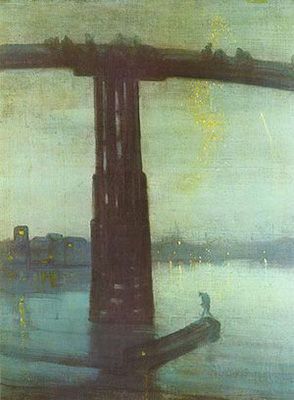
Nocturne: Blue and Gold - Old Battersea Bridge
This work depicts a night view of Battersea Bridge on the Thames River in London. The bridge was made of wood, and has since been replaced with a modern one. The view is painted at twilight, with mist on the river, vague lights of buildings in the distance and fireworks in the sky beyond. The effect is serene and romantic, concealing the river's pollution and the noisy reality of urban life. Unconcerned with creating a true-to-life depiction, Whistler focused instead on provoking an emotive response in the viewer through a soothing color palette, soft brushwork, and harmony of forms.
A longtime admirer of Ukiyo-e painter Katsushika Hokusai, Whistler composed the bridge in a manner that shared compositional similarities with Hokusai's Under the Mannen Bridge at Fukagawa (c. 1830-34). It was through images such as this that Whistler introduced characteristics of the Japanese aesthetic, including silhouetted forms, breathy brushwork, and flattened compositions, to British adherents to the Aesthetic movement.
The title "nocturne" refers to a musical composition inspired by the night. Whistler conceived of a deep connection between painting in the Aesthetic style and music, titling his paintings after musical forms in order to highlight their "tonal" similarities (comparing musical notes to paint colors) and to place the emphasis on their visual nature rather than on their narrative content. Indeed, Whistler produced this painting during his libel suit against Ruskin and asked the jury to consider his work not as a traditional painting, but rather as an artistic arrangement. He argued that "Art should be independent of all claptrap - should stand alone and appeal to the artistic sense of eye or ear without confounding this with emotions entirely foreign to it ..." Whistler's argument for sensorial similarities between painting and music proved to be particularly influential to German Expressionist painter Wassily Kandinsky, who expanded on Whistler's ideas by creating images as abstract as music itself, drawing upon a correlation between colors and musical notes.
Oil on canvas - Collection of the Tate, United Kingdom
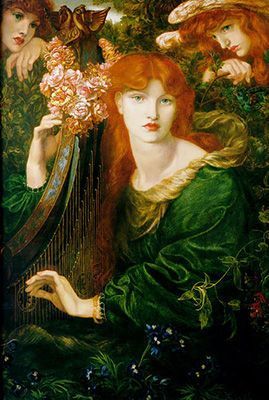
La Ghirlandata
La Ghirlandata (meaning "the garlanded lady") is generally understood to be the "embodiment of love and beauty." Different from Rossetti's earlier Pre-Raphaelite paintings, this image features a softening of line indicative of what has been described as the artist's sensual phase, a style that has more in common with painters of the Aesthetic movement. The painting displays a balanced and nearly symmetrical composition. At centre, a woman delicately strums a harp, her figure obscured beneath flowing drapery and layers of floral vegetation. The woman's delicate features are echoed in the faces of two angelic faces overhead. The color palette is vibrant and harmonious, with the green of her dress melding into the foliage, so that the complementary warm flesh tones and flaming locks of hair pop.
The model for the central figure is Alexa Wilding, whom Rossetti painted multiple times. Wilding was one of three models (the others being Jane Morris and Lizzie Siddal) who inspired the artist's vision for of new standard of beauty. Wilding's large, well-defined eyes and lips, and lush red hair point to an inherent sensuality in the work. Her appearance marks a distinct contrast to the petite facial features traditionally considered to be a marker of beauty by the Victorians. Rossetti also exalted his model's luxurious auburn hair, a trait associated with sexual licentiousness in Victorian England, as beautiful and alluring. Rossetti's red-haired beauties became an important motif of Aestheticism, with variations appearing in Aesthetic paintings as well as in the streets of London, as dying one's hair with henna became increasingly fashionable.
Oil on canvas - Guildhall Art Gallery, London
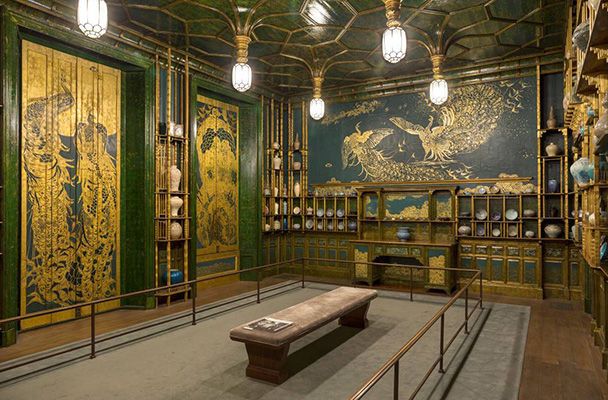
Harmony in Blue and Gold: The Peacock Room
Shipping magnate Frederick Leyland invited interior architect Thomas Jekyll to design a dining room for his London home that would both compliment a painting in situ by Whistler entitled The Princess from the Land of Porcelain (1863-65) and display the patron's collection of blue and white porcelain. Unable to finish the commission due to illness, Jekyll was soon replaced with Whistler, who was asked to put finishing touches on the room. Whistler, however, interpreted this as carte blanche and completely redesigned the space as he saw fit. He covered the walls with turquoise blue and golden murals, painted the ceiling gold, and adorned it with a design of blue peacock feathers (a typical Aesthetic motif). Whistler later explained, "I just painted on. I went on - without design or sketch - it grew as I painted. And toward the end I reached [...] a point of perfection." Whistler's finished room, as he described it, embodied "harmony in blue and gold."
Leyland, however, was not impressed when he discovered the liberty Whistler had taken. The two argued extensively over the artist's compensation. Infuriated, Whistler apparently returned to the room and painted a mural of two male peacocks fighting - an allusion to the artist's and patron's falling out. Whistler dubbed the panel "Art and Money; or, the Story of the Room."
The Peacock Room is recognized as the most important example of Aestheticism applied to interior design in order to create an inspirational environment. Such Aesthetic rooms elevated interior design to the realm of fine art. Its simplified, silhouetted forms, rich glazes, and reference to distinctly Japanese motifs, such as the peacock and bamboo, also make it an important example of the Anglo-Japanese style.
Oil paint and gold leaf on canvas, leather and wood - Freer Gallery, Washington DC
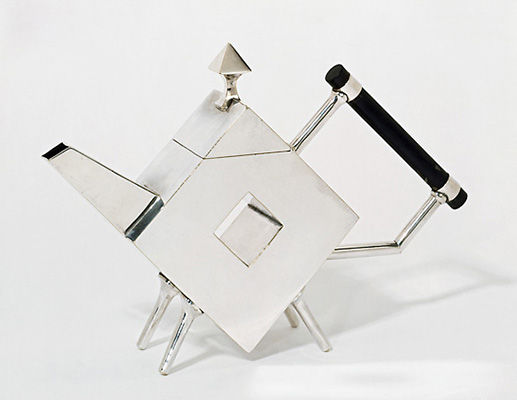
Teapot
This is one of many teapots designed by Christopher Dresser in the Aesthetic style between 1878 and 1879. Its clean lines and angularity contrast with traditional Victorian design, which was condemned by Aesthetes as fussy and complicated. Dresser was one of the first to realize that industrial design for household items was important, and that it could be achieved in a fashionable and artistic manner. The artist's metalwork in particular is recognized as an important precursor to the modern designs of the Bauhaus. The Victoria and Albert Museum describes Dresser as "an industrial designer before the profession had been invented, a man who found new ways of designing for production that few of his contemporaries could have imagined. He grasped both the properties of materials and the processes of production and adapted his designs and aesthetics to them brilliantly."
Dresser was particularly interested in Japanese art and design, traveling extensively in the East. The simplicity of the teapot's design, the geometric shapes and diagonals, and its ebony handle are evidentiary of Dresser's fascination with the Japanese aesthetic. Ultimately, Dresser, like William Morris and other Aesthetic designers, sought to bring beauty and good practical design into every area of life. He best articulated this shared goal when he said: "let us have objects which are useful, but let them be beautiful also." He became one of the most influential of a group of designers who helped to bring Aestheticism into the homes of the middle classes.
Silver and ebony - Victoria and Albert Museum, London
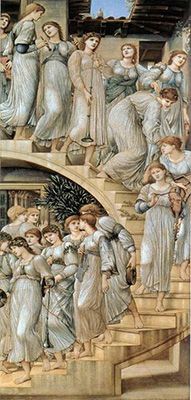
The Golden Stairs
Created for the Grosvenor Gallery's exhibition in 1880, The Golden Stairs is the Burne-Jones painting that most closely fits the ideals of the Aesthetic movement. Although many of the artist's paintings do include narrative content and moral messages, in The Golden Stairs he eschews this to create a composition entirely based on aesthetics. Each of the women walking down the elegant sweep of the golden stairs is wearing a similarly classicized gown, and each is proportioned to be tall and slim, echoing the shape of the painting itself. The figures' dresses are subtly different, providing decorative details that keep the viewer's eye interested but not overwhelmed. Each also carries a different musical instrument as they rhythmically descend stairs that have been described as a visual reference to musical scales. Undoubtedly a nod to Walter Pater's famous assertion that "all the arts aspire to the condition of music," the original title of the painting was Music on the Stairs.
Burne-Jones was a key figure who helped to bridge the gap between Pre-Raphaelitism and Aestheticism, creating works that fall under the rubrics of both movements. In this painting, although the faces and clothes of his figures are very similar to some of his earlier works and bear a resemblance to many of the Pre-Raphaelite women painted by Dante Gabriel Rossetti, the composition points more to the values of the Aesthetic movement. Unlike Pre-Raphaelite paintings, The Golden Stairs has no literary source. The subtle and harmonious color palette, as well as the absence of complex narrative or moral content, are also indicative of Aestheticism. Furthermore, the long, thin painting, measuring 9 x 4 feet, recalls the shape of a decorative wall panel rather than a traditional narrative canvas.
Oil on canvas - Collection of the Tate, United Kingdom
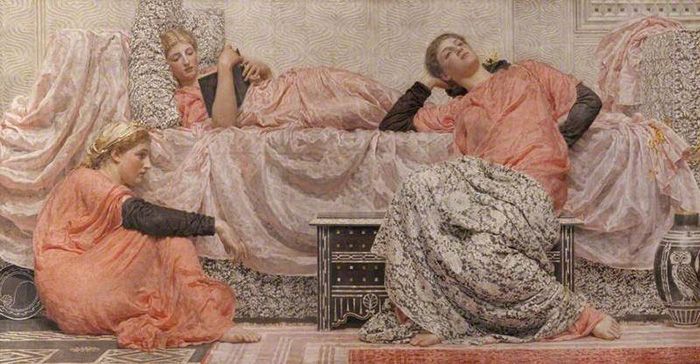
Reading Aloud
Albert Moore's paintings frequently depict women in moments of leisure, wearing elaborately draped classical-style dresses. In this example, two women lean against an extravagantly upholstered sofa as they listen intently to another reclining woman reading a book. The atmosphere is one of languor and relaxation, with the women situated in a semi-exotic environment that nonetheless lives up to Victorian standards of safety and decency. The scene lacks any narrative momentum so that the effect of the flattened, linear composition is purely decorative. Indeed, Moore frequently named his paintings after the work was finished, pointing to his determination to paint scenes that were primarily decorative rather than narrative.
Inspired by classical art, particularly the Elgin Marbles at the British Museum, Moore's painting is nonetheless not a replication of any specific ancient source. The artist borrowed only those aspects he needed to make a pleasing image. In this sense, his classicism becomes overwhelmed by Aestheticism. Unconcerned with historical accuracy or dramatic narrative, the artist, like his friend Whistler, focused on tonal harmony and aesthetic effect. Moore was particularly interested in the depiction of drapery. The profusion of fabric in this scene attests to his mastery of creating subtle color, movement, and textural variations. Moore developed a reputation for such classical imagery, helping to establish this theme within Aesthetic art and shed light on the movement's tendency to find inspiration wherever an artist discovered something he or she deemed visually appealing.
Oil on canvas - Kelingrove Art Gallery, Glasgow
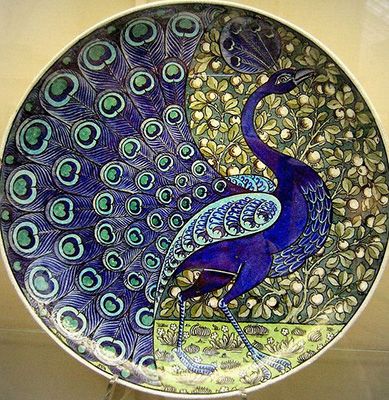
Charger
This large plate features an elaborate peacock in full plume. The arcing spread of the peacock's feathers echoes the curvature of the plate. The peacock's colorful display against a more subdued but no less intricate vegetal design presents a harmonious and carefully balanced composition. The male peacock was a key motif within the Aesthetic movement. In their more festive guises, male Aesthetes wore clothes as elaborate as their female counterparts, calling to mind the showy male peacock whose tail feathers consequently became a symbol for Aesthetes' expressive appearances.
Through ceramic work, such as Charger, William de Morgan revived the medieval luster technique. He experimented extensively with glazes and firing methods, eventually arriving at the artisanal techniques needed to translate Aestheticism into the medium of ceramics. In so doing, he helped elevate the decorative arts to the realm of fine art. Before establishing his own company, de Morgan worked with fellow designer and friend William Morris, creating aesthetic tiles and plates for Morris's firm. But, while Morris objected to Aestheticism's divorce moral obligations and gradually distanced himself from the movement, de Morgan maintained his interest in Aestheticism's pursuit of ideal beauty.
Glazed ceramic - Birmingham Museum, Birmingham, UK

The Bath of Psyche
An admirer of classical art, Frederic Leighton depicts Psyche from the popular legend of Cupid and Psyche, adopting a pose that echoes that of the ancient Greek sculpture Venus Callipyge (made as early as 300 BCE). The figure appears to be undressing before her bath, captivated by her own reflection in the water below. Psyche's association with mirrored reflections speaks to Aestheticism's emphasis on the visual and, in particular, its appreciation of ideal beauty.
Leighton revived the genre of the nude in Victorian England through paintings such as The Bath of Psyche. Victorian prudishness and preoccupation with sexual morality meant that by 1850 the ideal nude had largely disappeared from British art. Its reappearance in the paintings by Leighton and his Aesthetic comrades sparked moral outrage and heated public debate in the 1880s. Beyond the threat to ethical decency, Leighton's nude figures were further criticized for their resemblance to the real (rather than ideal) female form as well as their waxen, bloodless appearance.
This painting was originally intended to be one of several commissioned by classical painter Sir Lawrence Alma-Tadema for his North London home. Alma-Tadema asked various artists to paint a panel 32 inches high and 6.5 inches wide. However, Leighton, President of the Royal Academy at the time, insisted that this was impossible; one story suggests that he picked up a knife, pointed to the slim blade, and asked, "my dear Tadema, what sort of subject do you expect me to paint on this?" The final width was closer to 24 inches, but the panel is still tall and thin, an unusual shape for a fine art canvas. Its dimensions point to the Aesthetic taste for using fine art as a decorative element, in this case a wall panel, for a room, attempting to find a harmony between architecture and ornamentation.
Oil on canvas - Collection of the Tate, United Kingdom

Leighton House
In 1864, Frederic Leighton commissioned architect George Aitchison to build a studio and house for him on a plot of land in London's Chelsea District. The original building was relatively modest in size, with an elegant classical facade. However, over the next 30 years Leighton asked Aitchison to extend and revise the house, resulting in a unique building that represents the zenith of Aesthetic architecture and interior design. Intended to be a "private palace of art," Leighton House featured art, textiles, and furnishings arranged with attention to their aesthetic effect and with little consideration for objects' historical or cultural significance.
The house famously features the two-story "Arab Hall" inspired by the palace of La Zisa in Palermo, Sicily. Designed to contain Leighton's collection of tiles, ceramics, and carpets acquired on his travels to Turkey, Syria, and Egypt, the room boasts a gold leaf dome framed by a mosaic frieze designed by Walter Crane, beautiful wooden lattice windows, and large ottoman seats upholstered in William Morris's fabrics. In 1895, the final addition of a picture gallery, known as the Silk Room, appeared. Recalling Italian Renaissance structures, this light-filled room features a classical frieze and a minstrels' gallery. It would have been filled with Leighton's own paintings as well as work by friends, including John Everett Millais and John Singer Sargent.
In an interesting contrast to the luxurious furnishings elsewhere, the only bedroom in the house contains Leighton's small iron-framed bed. This perhaps points to the fact that, for many people, the sensual delights of the Aesthetic movement were purely to be experienced in a visual way, and did not necessarily translate into real life. Nonetheless, The Leighton House exemplifies the prosperity and social status some successful Victorian artists enjoyed.
12 Holland Park Road, London
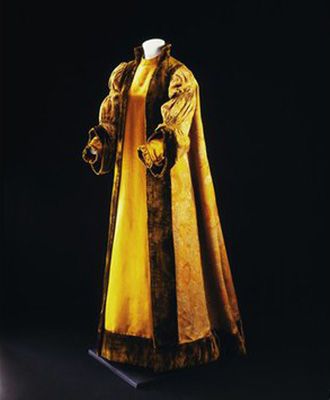
Robe
This long and flowing robe with full, puffy sleeves recalls medieval dress, which was an important source of inspiration for the Pre-Raphaelites. Similarly loose apparel featured prominently in Pre-Raphaelite paintings by artists such as Rossetti. This type of free-flowing fashion and the Pre-Raphaelite concept of ideal female beauty was embraced by women in succeeding decades.
The garment was designed and produced by Liberty of London, one of the first department stores that catered to contemporary taste for the fashionable Aesthetes. The subtle brown and gold tones were deemed "artistic" at the time, while the loose, flowing silhouette was celebrated as healthier than the tight, restrictive corsets which had been in fashion during the Victorian era. The popularity of such attire is evidence of the extent to which the Aesthetic movement affected design in the consumer sphere.
Silk and cotton brocade, lined with taffeta, with a silk-satin front panel - Victoria and Albert Museum, London
Beginnings of The Aesthetic Movement
The Great Exhibition of 1851 marked a turning point for the visual arts in Britain. Although the event showcased important recent innovations, including the new medium of photography, much of the work on display conformed to the fussy and shallow design style of the Victorian era. Worse still was the mechanization of the creation process, which according to famous critic John Ruskin, meant the dehumanization of design. These predictable, repetitive designs coupled with the strict Victorian standards for art that placed greater importance on the moral message conveyed than quality of the work fostered a stifling environment from which many artists were desperate to escape.
Pre-Raphaelite Roots
Shortly after the Great Exhibition concluded, a group of artists went about creating a new and simpler aesthetic - one inspired by the intricate detail and intense colors of medieval art and design. Art of the so-called Pre-Raphaelite Brotherhood gained popularity by the 1860s thanks in part to favorable reviews by John Ruskin. The group split thereafter when younger artists, including William Morris and Edward Burne-Jones, joined Dante Gabriel Rossetti to create a "Cult of Beauty," laying the foundation for Aestheticism. Rossetti's sensual portraits of unconventionally beautiful women with large eyes and flaming red hair adorned in loose, flowing gowns introduced a new ideal for feminine beauty that challenged Victorian associations between non-corseted, red-haired women and sexual licentiousness; and eventually became an importance motif of the Aesthetic movement.
The Japanese Influence
When in 1854 Japan began openly trading with foreign powers, their products flooded the British market. Artists and consumers alike were captivated by the stylized organic motifs, circular designs, and geometric patterns that characterized this new aesthetic. Its simplicity and elegance of form contrasted sharply with overcrowded and busy Victorian designs. British consumers began collecting Japanese screens, fans, and porcelain, as well as staining their furniture ebony in imitation of Japanese lacquer. Painters, such as James Abbott McNeill Whistler, began incorporating these items into their work, while also modifying their compositions to reflect the original aesthetic. Designers E.W. Godwin and Christopher Dresser were similarly inspired. Gradually a new style emerged within the Aesthetic movement known as the Anglo-Japanese style.
Art for Art's Sake
Aesthetic artists, like their Pre-Raphaelite predecessors, placed a great deal of importance on a work's visual composition. But whereas Pre-Raphaelite art almost always contained a degree of narrative content, Aesthetic artists generally avoided any clear storyline or message. Instead they strove to evoke a mood, explore color harmony, or rediscover the intricate details they associated with superior craftsmanship. Drawing on diverse sources, such as Ancient Greek, Japanese, and Medieval art, they loudly touted their motto: "art for art's sake," taken from French critic and poet Theophile Gautier's novel Mademoiselle de Maupin (1836). This modern notion that art should be evaluated on the basis of its own criteria rather than the subject's significance or truthful depiction, became a rallying cry for artists eager to separate art from Victorian materialism. Walter Pater became one of the most important voices of the Aesthetic movement when he argued for the primacy of the viewer's aesthetic experience of art in Studies in the History of the Renaissance (1873). According to Pater, "Of such wisdom, the poetic passion, the desire of beauty, the love of art for its own sake, has most. For art comes to you proposing frankly to give nothing but the highest quality of your moments as they pass, and simply for these moments sake."
The Grosvenor Gallery
When the Grosvenor Gallery on Bond Street opened in 1877, it provided a space for artists, most notably Aesthetic artists, to exhibit work that conflicted with the Royal Academy's classical expectations. In particular, it promoted the careers of James Abbott McNeill Whistler, Albert Moore, George Frederic Watts, and Edward Burne-Jones. The Grosvenor Gallery was not only the first to have electric lights; it also introduced a new method of display (now the standard method for galleries and museums) wherein paintings were hung with ample spacing to facilitate the viewer's absorption, as described by Walter Pater. Designed to mimic a picture gallery in a private residence, the exhibition space was surrounded by other sumptuously decorated rooms that adhered to the Aesthetic rules of design. Adornments included ionic pilasters with gilt capitals, green Genoan marble, a wide staircase, and green and yellow silk damask covered walls, prompting it to be mocked as the "greenery-yallery Grosvenor Gallery" in Gilbert and Sullivan's comic opera Patience.
Condemnation by Ruskin
Noted critic John Ruskin praised the Pre-Raphaelites' creative expression and agreed that standards of design for machine-produced decorative arts had declined so much so that they had become repetitive, lacking soul and quality craftsmanship. However, he also advocated for the social utility of art, which directly conflicted with the Aesthetic movement's "art for art's sake" mentality. For Ruskin, art was not simply a matter of taste, but also a conveyor of intellect, feeling, morality, and knowledge. When the Grosvenor Gallery opened in 1877 with an exhibition of work by Burne-Jones and Whistler, Ruskin published a scathing review of the latter's Nocturne in Black and Gold: The Falling Rocket (1874). Objecting to what he perceived to be meaningless content carelessly created, Ruskin wrote, "I have seen, and heard, much of cockney impudence before now; but never expected a coxcomb to ask two hundred guineas for flinging a pot of paint in the public's face..." Whistler filed a libel suit against Ruskin the following year and, although the artist's victory yielded a mere farthing in damages, it proved to be detrimental to Ruskin's critical career, which never fully recovered. Ruskin, who had been responsible for elevating the careers of several Pre-Raphaelite painters during the 1850s, now found himself out of sync with the up-and-coming modern art movement.
The Aesthetic Movement: Concepts, Styles, and Trends
Painting
Inspired by Rossetti's sensual female portraits, Aestheticism made its first appearance in paintings. Through this medium, the movement and its values trickled into other fields. Of all Aesthetic artists, painters were perhaps best equipped to realize the movement's goal of creating art for art's sake. This is because paintings, unlike the decorative arts and fashion, for example, can be separated from utilitarian functions quite easily. Thus, painters like Moore, Whistler, and Leighton were able to focus entirely on creating beautiful compositions that were pleasing to the senses. Because oil paints allow for subtle tonal changes, Aesthetic painters could use the medium to explore color harmonies and tonal variety. Many of these artists, particularly Whistler, also incorporated Japanese motifs (peacocks, fans, vases) and aesthetics (such as feathery brushwork or simplified forms) into their work.
Music
Although some Victorian musicians, most notable Eduard Hanslick, championed formalism and the separation of music from any obligation to express something beyond itself, there appear to have been no specifically Aesthetic musicians. Nonetheless, the medium was an important source of inspiration for many Aesthetic painters. In the 1870s, the critic Walter Pater famously asserted that "all the arts aspire to the condition of music." This was taken to heart by Aesthetic artists who believed that music provided an ideal form of art that painting could emulate. This process involved eradicating narrative content in favor of creating an impression or evocation through the "harmony" of colors and composition. Painters, such as Whistler and Frederick Leighton, even titled their paintings after musical forms. Whistler explained the connection between art and music and the artist's role as creator: "Nature contains the elements, in color and form, of all pictures, as the keyboard contains the notes of all music. But the artist is born to pick, and choose, and group with science, these elements, that the result may be beautiful - as the musician gathers his notes, and forms his chords, until he brings forth from chaos glorious harmony."
Architecture
Houses and studios designed by and erected under the supervision of Aesthetes deviated from the classical academic tradition by bringing together seemingly disparate sources of inspiration to create a unique structural layout. Frederic Leighton's house, for example, incorporated Oriental, Middle-Eastern, and Italian Renaissance references. Instead of a traditional British foyer or tearoom, guests enter into what is called "Arab Hall," an elaborately decorated domed room that blends many different middle-eastern design elements. Meanwhile, Whistler designed the famous Peacock Room for the shipping magnate Frederic Leyland, which was inspired by a Japanese lacquer box. These eclectic homes often demanded collaboration among industrial artists, such as William Morris and Charles Voysey. For Aesthetic architects and designers, the beauty of the structure as a reflection of its complex inhabitants trumped adherence to any one style.
Design
The Aesthetic movement saw, for the first time, designers being recognized and even made famous for their excellent craftsmanship. Before Aestheticism, designers were rarely credited. But thanks in part to designer-poet-socialist William Morris, design as a profession gained legitimacy as an art form. Famous designers of the era included Christopher Dresser, Edward Godwin, and William Morris himself. These artists created furniture, metalwork, textiles, and ceramics characterized by geometric designs, stylized floral, vegetal, and zoomorphic motifs inspired by medieval and Japanese aesthetics. These designs offered clean lines and simplicity of form intended to be an antidote to the fussiness of most Victorian products. Some designers, like Morris, established their own brand. Others, including Walter Crane and Christopher Dresser, collaborated with shops and manufacturers to create products for middle-class homes. Thanks to Oscar Wilde's notion of "the house beautiful," which asserted that a home's interior should be as beautiful as possible with the aim of providing an inspirational environment for its inhabitants, Aesthetic shops offering such products prospered. The most famous of these was Arthur Liberty's of London, which opened in 1875 and sold textiles from the Middle East and Japan as well as specially designed Aesthetic style consumer goods.
Fashion
By the 1890s, Aesthetic shops were marketing consumer products to satiate the public's desire to play the part of the Aesthete. For some, this meant dressing the part. Echoing the graceful beauties depicted in Rossetti's Pre-Raphaelite paintings, women abandoned restrictive corsets and heavy fabrics for more "bohemian" loose, unstructured dresses decorated with delicate floral embroidery. Some even enhanced their hair color with henna. Men, inspired by the extravagant male peacock (a popular motif of the Aesthetic movement), dressed the part of the foppish dandy, favoring velvet jackets, flowing ties, and breeches. Playwright and novelist Oscar Wilde, the ultimate dandy, became the celebrity symbol most closely associated with the movement. Like many other Aesthetic men, Wilde was ridiculed for his fashion sense. He received considerable criticism, for example, when he attended the opening of the Grosvenor Gallery wearing a flamboyant suit designed to look like a cello.
Literature
For Aesthetic literature, as in the visual arts, beauty of form trumped conveying a social or moral message. Inspired by Walter Pater's essays of the late 1860s, Aesthetic writers, most notably Oscar Wilde and Algernon Charles Swinburne, composed poems and prose that were sensuous and riddled with suggestions rather than clear statements. Aesthetic poems and writers were scorned and satirized by their Victorian peers, including Gilbert and Sullivan as well as the editors of Punch magazine.
Later Developments - After The Aesthetic Movement
The popular success of Aestheticism seemed assured when Aesthetic painter Frederic Leighton became President of the Royal Academy in 1878. Leighton made it his mission to ensure that paintings by non-academicians received equal consideration and were prominently displayed at their annual spring exhibition. He also nominated other Aesthetic artists, including Albert Moore and Edward Burne-Jones, for election to the Academy.
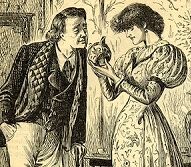
Although Aestheticism was popular with many people, it also became the subject of ridicule. In 1881, Gilbert and Sullivan wrote Patience, a comic opera which mocked Aesthetes and their ideals, while George du Maurier produced a famous cartoon that depicted a stylish "Aesthetic" couple worrying about whether they could live up to the example of their beautiful teapot.
The absence of a single, cohesive philosophy to bind members of the movement together meant that some artists gravitated in different directions. Socialist William Morris, for example, complained of "ministering to the swinish luxury of the rich" and sought to make his work available to the masses, not just progressive aristocrats. His ideas gathered strength and Morris became a leading proponent of the Arts and Crafts movement. In Britain, his involvement inspired designers to revive pre-industrial techniques to distinguish their craftsmanship from machine-made products. In Germany, where distain for modern machinery was not as pervasive, the Bauhaus movement reconciled what Morris could not. They combined aesthetic notions of craft and design with modern technology to mass-produce quality designs for household items, particularly furniture.
Still other Aesthetes, most notably Oscar Wilde and Aubrey Beardsley, delved deeper into shocking Victorian society out of its complacency. Their efforts evolved into the Decadent movement, which quickly faded in popularity when it became associated with immorality and sexual promiscuity, in part because of Oscar Wilde's trial and imprisonment for "gross indecency" with men.
Although public perception of Wilde's involvement with the Aesthetic movement meant that it, too, suffered, the modern notion of "art for art's sake" affirmed the movement's place in art history. The idea that art had its own intrinsic value released it from the obligation of having a moral or historical meaning. This rejection of the past (of historical or mythological narratives) became vital for modern painters. The artist, it was thought, should have freedom of expression - in terms of subject choice and stylistic representation. This concept of self-expression combined with an eagerness to explore the formal aspects of painting (color, form, and composition), culminated in the Abstract Expressionist movement of the mid-20th century and continues to be a basis of creative exploration for many contemporary artists in the 21st century.
Useful Resources on The Aesthetic Movement
- William Morris: Romantic to RevolutionaryBy E.P. Thompson
- Life and Art of Dante Gabriel RossettiBy Sir Hall Caine
- The Life, Letters and Work of Frederic LeightonBy Mrs. Russell Barrington
- The Aesthetic MovementOur PickBy Lionel Lambourne
- The Aesthetic Movement in EnglandBy Walter Hamilton
- After the Pre-Raphaelites: Art and Aestheticism in Victorian EnglandOur PickBy Elizabeth Prettejohn
- The New Painting of the 1860s: Between the Pre-Raphaelites and the Aesthetic MovementBy Allen Staley
- Art for Art's Sake: Aestheticism in Victorian PaintingBy Elizabeth Prettejohn
 Ask The Art Story AI
Ask The Art Story AI